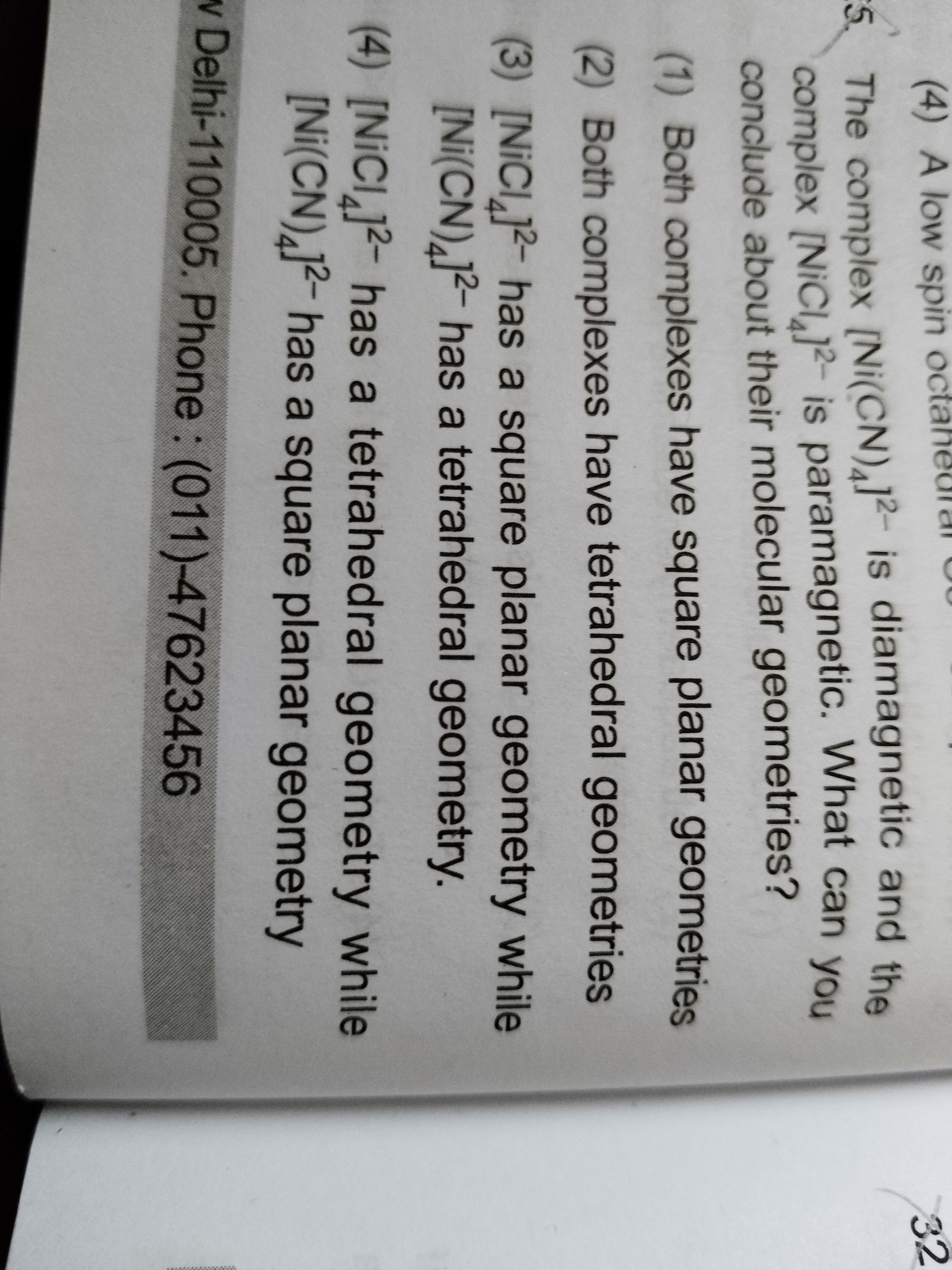Question
Question: The complex $[Ni(CN)_4]^{2-}$ is diamagnetic and the complex $[NiCl_4]^{2-}$ is paramagnetic. What c...
The complex [Ni(CN)4]2− is diamagnetic and the complex [NiCl4]2− is paramagnetic. What can you conclude about their molecular geometries?

Both complexes have square planar geometries
Both complexes have tetrahedral geometries
[NiCl4]2− has a square planar geometry while [Ni(CN)4]2− has a tetrahedral geometry.
[NiCl4]2− has a tetrahedral geometry while [Ni(CN)4]2− has a square planar geometry
[NiCl4]2− has a tetrahedral geometry while [Ni(CN)4]2− has a square planar geometry
Solution
Here's the solution based on the magnetic properties of the complexes:
-
Determine the oxidation state of Ni: In both complexes, [Ni(CN)4]2− and [NiCl4]2−, the oxidation state of Ni is +2.
- For [Ni(CN)4]2−: x+4(−1)=−2⟹x=+2
- For [NiCl4]2−: x+4(−1)=−2⟹x=+2
-
Determine the electronic configuration of Ni2+: Nickel (atomic number 28) has the electronic configuration [Ar]3d84s2. Ni2+ has the configuration [Ar]3d8.
-
Consider the ligands: CN− is a strong field ligand (SFL), and Cl− is a weak field ligand (WFL).
-
Analyze [Ni(CN)4]2−:
- Ni2+ is d8.
- CN− is a SFL.
- The complex is diamagnetic (no unpaired electrons).
- For a d8 ion, square planar geometry with SFLs leads to complete pairing of electrons, resulting in a diamagnetic complex. The hybridization is dsp2. The crystal field splitting in a square planar field is large, pushing the dx2−y2 orbital to a much higher energy. The 8 electrons fill the lower energy orbitals (dxz,dyz,dz2,dxy) completely.
- Tetrahedral geometry for a d8 ion results in 2 unpaired electrons in the t2g orbitals (eg)4(t2g)4, making it paramagnetic.
- Since [Ni(CN)4]2− is diamagnetic, its geometry must be square planar.
-
Analyze [NiCl4]2−:
- Ni2+ is d8.
- Cl− is a WFL.
- The complex is paramagnetic (has unpaired electrons).
- For a d8 ion, tetrahedral geometry with WFLs leads to 2 unpaired electrons (eg)4(t2g)4, making it paramagnetic. The hybridization is sp3.
- Square planar geometry for a d8 ion with WFLs could theoretically be paramagnetic if the splitting was small enough to overcome pairing energy, but the typical behaviour for d8 square planar complexes is diamagnetic. Given the observed paramagnetism with a WFL like Cl−, the geometry is likely tetrahedral.
- Since [NiCl4]2− is paramagnetic, its geometry must be tetrahedral.
-
Conclusion: [Ni(CN)4]2− has a square planar geometry, and [NiCl4]2− has a tetrahedral geometry.
